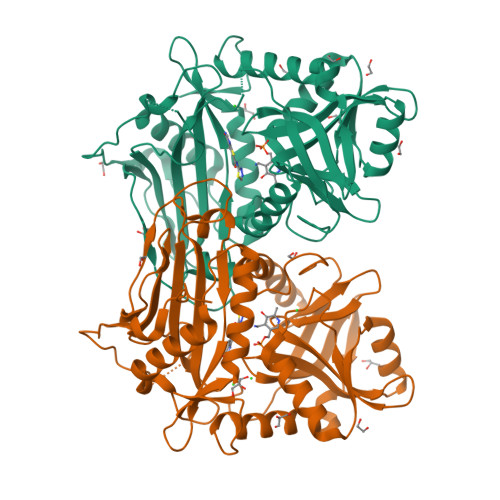
Top ▲

GtoPdb is requesting financial support from commercial users. Please see our sustainability page for more information.
Target not currently curated in GtoImmuPdb
Target id: 2893
Nomenclature: branched chain amino acid transaminase 2
Gene and Protein Information  |
||||||
| Species | TM | AA | Chromosomal Location | Gene Symbol | Gene Name | Reference |
| Human | - | 392 | 19q13.33 | BCAT2 | branched chain amino acid transaminase 2 | 1 |
| Mouse | - | 393 | 7 29.36 cM | Bcat2 | branched chain aminotransferase 2, mitochondrial | |
| Rat | - | 393 | 1q22 | Bcat2 | branched chain amino acid transaminase 2 | 1 |
| Gene and Protein Information Comments | ||||||
| For the human gene and protein we provide details for the longest form, isoform a (from transcript variant a) also known as PP18a. Isoforms b and c (PP18b, PP18c) are shorter at 300 and 352 amino acids (aa) respectively. Two mouse isoforms are produced from 3 transcript variants. Isoform 1 is the longest (details in the table), with isoform 2 having a shorter N-terminus (353 aa). | ||||||
Database Links  |
|
| Alphafold | O15382 (Hs), O35855 (Mm), O35854 (Rn) |
| BRENDA | 2.6.1.42 |
| ChEMBL Target | CHEMBL3616354 (Hs), CHEMBL3319 (Rn) |
| Ensembl Gene | ENSG00000105552 (Hs), ENSMUSG00000030826 (Mm), ENSRNOG00000020956 (Rn) |
| Entrez Gene | 587 (Hs), 12036 (Mm), 64203 (Rn) |
| Human Protein Atlas | ENSG00000105552 (Hs) |
| KEGG Enzyme | 2.6.1.42 |
| KEGG Gene | hsa:587 (Hs), mmu:12036 (Mm), rno:64203 (Rn) |
| OMIM | 113530 (Hs) |
| Pharos | O15382 (Hs) |
| RefSeq Nucleotide | NM_001190 (Hs), NM_001164773 (Hs), NM_001284325 (Hs), NM_001243052 (Mm), NM_001243053 (Mm), NM_009737 (Mm), NM_022400 (Rn) |
| RefSeq Protein | NP_001158245 (Hs), NP_001181 (Hs), NP_001271254 (Hs), NP_001229982 (Mm), NP_033867 (Mm), NP_001229981 (Mm), NP_071795 (Rn) |
| UniProtKB | O15382 (Hs), O35855 (Mm), O35854 (Rn) |
| Wikipedia | BCAT2 (Hs) |
Selected 3D Structures  |
|||||||||||||

|
|
||||||||||||
Enzyme Reaction  |
||||||||||
|
||||||||||
Download all structure-activity data for this target as a CSV file 
| Inhibitors | |||||||||||||||||||||||||||||||||||||||||||||||||||||||||||||||||||||||||||||||||||||||||||||||||||||||||||||||||||
| Key to terms and symbols | View all chemical structures | Click column headers to sort | |||||||||||||||||||||||||||||||||||||||||||||||||||||||||||||||||||||||||||||||||||||||||||||||||||||||||||||||||
|
|||||||||||||||||||||||||||||||||||||||||||||||||||||||||||||||||||||||||||||||||||||||||||||||||||||||||||||||||||
| Immuno Process Associations | ||||||||||||
|
||||||||||||
| Tissue Distribution Comments | |
| In mammals, BCAT2 (BCATm) is expressed in most tissues [4]. In comparison, expression of the cytosilic isozyme BCAT1 (BCATc; UniProt P54687) is restricted to the CNS. |
Physiological Consequences of Altering Gene Expression 
|
||||||||||
|
| General Comments |
|
BCAT2 is a mitochondrial protein that catalyses the first step in the production of the branched chain amino acids leucine, isoleucine, and valine. HGNC places this protein in the minor histocompatibility antigen (MHA) family. MHAs are known to induce an immunological response in some organ transplants, albeit to a much lesser degree than the major histocompatibility complex (MHC) antigens. Amino acid differences in MHAs can cause slow rejection of transplanted organs even when MHCs are comprehensively matched between donor and recipient. |
1. Bledsoe RK, Dawson PA, Hutson SM. (1997) Cloning of the rat and human mitochondrial branched chain aminotransferases (BCATm). Biochim Biophys Acta, 1339 (1): 9-13. [PMID:9165094]
2. Borthwick JA, Ancellin N, Bertrand SM, Bingham RP, Carter PS, Chung CW, Churcher I, Dodic N, Fournier C, Francis PL et al.. (2016) Structurally Diverse Mitochondrial Branched Chain Aminotransferase (BCATm) Leads with Varying Binding Modes Identified by Fragment Screening. J Med Chem, 59 (6): 2452-67. [PMID:26938474]
3. Günther J, Hillig RC, Zimmermann K, Kaulfuss S, Lemos C, Nguyen D, Rehwinkel H, Habgood M, Lechner C, Neuhaus R et al.. (2022) BAY-069, a Novel (Trifluoromethyl)pyrimidinedione-Based BCAT1/2 Inhibitor and Chemical Probe. J Med Chem, 65 (21): 14366-14390. [PMID:36261130]
4. Hutson S. (2001) Structure and function of branched chain aminotransferases. Prog Nucleic Acid Res Mol Biol, 70: 175-206. [PMID:11642362]
5. She P, Reid TM, Bronson SK, Vary TC, Hajnal A, Lynch CJ, Hutson SM. (2007) Disruption of BCATm in mice leads to increased energy expenditure associated with the activation of a futile protein turnover cycle. Cell Metab, 6 (3): 181-94. [PMID:17767905]
2.6.1.42 Branched-chain-amino-acid transaminase: branched chain amino acid transaminase 2. Last modified on 31/10/2022. Accessed on 02/07/2025. IUPHAR/BPS Guide to PHARMACOLOGY, https://www.guidetopharmacology.org/GRAC/ObjectDisplayForward?objectId=2893.